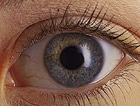Salivary Gland Biopsy May Diagnose Parkinson's Disease
Drug & Reference Information
Salivary gland biopsy appears to be a diagnostic test for Parkinson's disease, a new study suggests.
A biopsy of the submandibular gland that shows the presence of the abnormal protein alpha-synuclein is highly indicative of Parkinson's, as distinct from other neurodegenerative disorders that can mimic the disease, said lead study author, Charles Adler, MD, PhD, from the Mayo Clinic Arizona, Scottsdale, Arizona.
"There is currently no diagnostic test for Parkinson's disease in living patients. The only way to make the diagnosis is at autopsy, when you can see an abnormal protein, alpha-synuclein, in certain brain regions," Dr. Adler, a fellow of the American Academy of Neurology, told Medscape Medical News.
Their preliminary findings were released January 10; full results will be presented at the American Academy of Neurology's 65th Annual Meeting in San Diego.
Densest Concentration
Dr. Adler and his team have been working on determining whether there is evidence of alpha-synuclein in other organs of the body so that they could develop a diagnostic test in living patients.
"We previously published the fact that the submandibular
gland has one of the densest concentrations of alpha-synuclein in
an organ outside the brain. When we tested this in an
autopsy study of 28 Parkinson's disease patients, we found that all
28 of them had alpha-synuclein in the submandibular gland,"
he said.
The discovery led the researchers to biopsy the submandibular gland in living patients with Parkinson's disease to see whether this protein was present. If it was, then the biopsy could potentially be used as a diagnostic test, they reasoned.
The current study involved 11 patients, average age, 67.8 years (range, 61 to 76 years), with a mean duration of Parkinson's disease of 10.4 years (range, 6 to 14 years). All patients were responsive to dopaminergic medication and did not have dementia or any known salivary gland disorders.
The researchers used local anesthesia to perform core needle biopsies of 1 submandibular gland percutaneously using 18- or 16-gauge needles. They extracted up to 5 needle samples 240 to 535 μm thick, as well as samples from 2 to 5 minor salivary glands. The biopsies necessitated 1 to 3 stitches.
The patients tolerated the biopsies very well, Dr. Adler said. Three patients had 1 adverse event each, including a swollen cheek, a sore throat, and excess fluid that was expelled from the needle biopsy site after a sneeze.
Nine of the 11 patients showed evidence of alpha-synuclein in their salivary gland biopsy specimens.
"This really was a feasibility study, and it was important to do this in people who we felt had a higher certainty of having Parkinson's disease. They had symptoms for a long time and they were responsive to medication," Dr. Adler said.
Next Steps
The next step is to perform biopsy in patients who have had Parkinson's disease symptoms for a shorter duration.
"In people with more recent onset of disease, the accuracy of our clinical diagnosis is not as high. A lot of people who look like they have Parkinson's disease early on really don't have it, so we'd like to see if this biopsy test would be able to prove the presence of PD in earlier-onset, shorter-duration patients," he said.
Making a more accurate diagnosis in living individuals may improve the outcome of clinical trials, as well as the outcome of invasive procedures that are currently done for people with Parkinson's disease, he added.
"Doing the biopsy and finding the abnormal protein would tell us that we are in fact treating Parkinson's disease because before, we wouldn't be quite sure. There are a number of different studies, including data from our own which we haven't published yet, showing that the accuracy of the clinical diagnosis ranges anywhere from about 50% when somebody first presents with what looks like Parkinson's disease, up to about 80 to 90% for somebody who has had the disease for 5 or 10 years," Dr. Adler said.
"So, even at 10 years, accuracy is still not 100% for what we see clinically because there are many different neurodegenerative diseases that look like Parkinson's disease."
This study was funded by the Michael J. Fox Foundation for Parkinson's Research. Dr. Adler has disclosed no relevant financial relationships.
American Academy of Neurology 65th Annual Meeting. Abstract 1777. Released January 10, 2013.
A biopsy of the submandibular gland that shows the presence of the abnormal protein alpha-synuclein is highly indicative of Parkinson's, as distinct from other neurodegenerative disorders that can mimic the disease, said lead study author, Charles Adler, MD, PhD, from the Mayo Clinic Arizona, Scottsdale, Arizona.
"There is currently no diagnostic test for Parkinson's disease in living patients. The only way to make the diagnosis is at autopsy, when you can see an abnormal protein, alpha-synuclein, in certain brain regions," Dr. Adler, a fellow of the American Academy of Neurology, told Medscape Medical News.
Their preliminary findings were released January 10; full results will be presented at the American Academy of Neurology's 65th Annual Meeting in San Diego.
Densest Concentration
Dr. Adler and his team have been working on determining whether there is evidence of alpha-synuclein in other organs of the body so that they could develop a diagnostic test in living patients.

|
Dr. Charles Adler
|
The discovery led the researchers to biopsy the submandibular gland in living patients with Parkinson's disease to see whether this protein was present. If it was, then the biopsy could potentially be used as a diagnostic test, they reasoned.
The current study involved 11 patients, average age, 67.8 years (range, 61 to 76 years), with a mean duration of Parkinson's disease of 10.4 years (range, 6 to 14 years). All patients were responsive to dopaminergic medication and did not have dementia or any known salivary gland disorders.
The researchers used local anesthesia to perform core needle biopsies of 1 submandibular gland percutaneously using 18- or 16-gauge needles. They extracted up to 5 needle samples 240 to 535 μm thick, as well as samples from 2 to 5 minor salivary glands. The biopsies necessitated 1 to 3 stitches.
The patients tolerated the biopsies very well, Dr. Adler said. Three patients had 1 adverse event each, including a swollen cheek, a sore throat, and excess fluid that was expelled from the needle biopsy site after a sneeze.
Nine of the 11 patients showed evidence of alpha-synuclein in their salivary gland biopsy specimens.
"This really was a feasibility study, and it was important to do this in people who we felt had a higher certainty of having Parkinson's disease. They had symptoms for a long time and they were responsive to medication," Dr. Adler said.
Next Steps
The next step is to perform biopsy in patients who have had Parkinson's disease symptoms for a shorter duration.
"In people with more recent onset of disease, the accuracy of our clinical diagnosis is not as high. A lot of people who look like they have Parkinson's disease early on really don't have it, so we'd like to see if this biopsy test would be able to prove the presence of PD in earlier-onset, shorter-duration patients," he said.
Making a more accurate diagnosis in living individuals may improve the outcome of clinical trials, as well as the outcome of invasive procedures that are currently done for people with Parkinson's disease, he added.
"Doing the biopsy and finding the abnormal protein would tell us that we are in fact treating Parkinson's disease because before, we wouldn't be quite sure. There are a number of different studies, including data from our own which we haven't published yet, showing that the accuracy of the clinical diagnosis ranges anywhere from about 50% when somebody first presents with what looks like Parkinson's disease, up to about 80 to 90% for somebody who has had the disease for 5 or 10 years," Dr. Adler said.
"So, even at 10 years, accuracy is still not 100% for what we see clinically because there are many different neurodegenerative diseases that look like Parkinson's disease."
This study was funded by the Michael J. Fox Foundation for Parkinson's Research. Dr. Adler has disclosed no relevant financial relationships.
American Academy of Neurology 65th Annual Meeting. Abstract 1777. Released January 10, 2013.
==================================================================
Interesting! from Medscape!
Interesting! from Medscape!



No comments:
Post a Comment